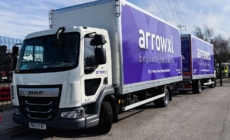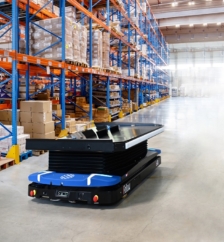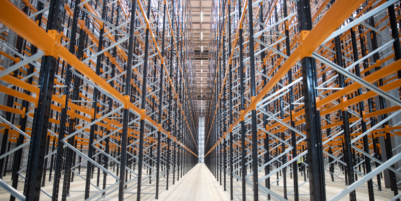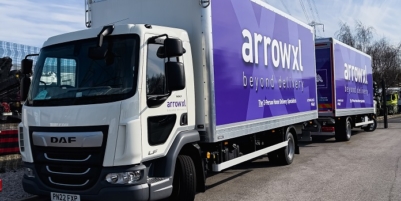-
ROSSLARE EUROPORT TARGETS HEALTH & SAFETY WITH CAMERA TELEMATICS PARTNERSHIP - 2 days ago
-
Landmark Study Reveals Wearable Robotics Significantly Boost Safety and Efficiency in Industrial Environments - July 24, 2024
-
Visku Tackle The Retail Seasonality Challenge One Pallet At A Time - July 22, 2024
-
KAMMAC AND BERGEN LOGISTICS STRENGTHEN FASHION & LIFESTYLE SERVICES IN THE UK - July 19, 2024
-
TENTBOX EXTENDS PARTNERSHIP WITH ARROWXL TO SUPPORT INCREASING DEMAND - July 17, 2024
-
The Perfume Shop improves customer journeys while driving profitability in partnership with Scurri - July 17, 2024
-
ZEROMISSION SECURES £2.3M ($3M) INVESTMENT TO ACCELERATE ELECTRIC FLEETS - July 16, 2024
-
BCMPA CELEBRATES SUCCESS OF 2024 CONFERENCE - July 15, 2024
-
Best of the Best: Jungheinrich Celebrates Triple International Award Win - July 12, 2024
-
GOPLASTICPALLETS.COM CALLS ON NEW CHANCELLOR RACHEL REEVES TO CONSIDER PLASTIC PACKAGING TAX REFORM - July 10, 2024
A well-considered mobile robot implementation can transform the productivity of order picking and internal transport in a retailer’s warehouse to deliver rewards in challenging times for the sector, explains Frazer Watson, VP-Sales UK/Ireland at iFollow.
The challenges for major retailer chains, department stores and the FMCG businesses that supply them just keep coming. This means many are having to maximise what they have got, and this is where investment in automation and specifically in Autonomous Mobile Robots (AMRs) can bring strong rewards.
AMR solutions can offer the retailer real productivity improvements at little or no extra labour cost – with training being pretty straightforward. The warehouse operative’s working environment can be made less strenuous and often safer, which should help with labour retention. Productive use of expensive warehouse floor space is maximised and operations aren’t significantly delayed if a particular route is temporarily inaccessible.
Supply chains have to some extent normalised after the pandemic and the outbreak of war, and the online share of trade has dropped back to a ‘mere’ 26% from over a third, which is still a serious game-changer. Now we have the ‘cost of living crisis’ with high rates of inflation hacking at consumer purchase volumes. Meanwhile, relatively new and disruptive market entrants, of which the grocery ‘discounters’ are only the most obvious, continue to make inroads.
The responses by bricks’n’mortar retailers are many and varied – investment in more attractive shopfitting, creating shopping ‘experiences’, better front-of-store staff training, more useable technology around Point Of Sale, not to mention continuing product innovation and development and more targeted and effective marketing and promotion.
None of this comes cheap, but the expenditure will be all in vain if supply and distribution activities behind the store-front, and especially in the warehouse or distribution centre, are not at peak efficiency.
But improving productivity in the warehouse isn’t straightforward. Throwing labour at the problem is not the option it used to be. The workforce, or at least people prepared to work arduous shifts, just isn’t there and they are not jobs likely to attract ‘early retirers’ back into the labour force. There are other challenges: for example the pivot in much of the grocery sector towards smaller ‘convenience’ formats is significantly changing the nature of distribution centre operations: fewer pallet-loads out, more ‘little and often’ replenishment of orders picked by the case. Current warehouses and equipment are not necessarily best suited to meeting these challenges efficiently.
Rebuilding existing warehouse estate requires significant capital investment and is disruptive. Redesigning the supply network around new sites and builds is a challenge because the property just isn’t available.
A well-considered AMR implementation, however, can transform the productivity and the ergonomics of warehouse order picking, and internal transport more generally. Many retailers will have had experience of warehouse automation, not all of it happy. Fixed systems such as conveyors are expensive to install, involving extensive electrical and often structural engineering work; they are by definition inflexible both in their location and how they are used; they eat up a lot of aisle space; and are often incompatible with safe human co-operation. Man-on truck systems may also have safety issues even if driven, as they should be, by people with very transferable, and expensive, skills. Some will have tried Automated Guided Vehicles (AGVs) but these too are inflexible, being confined to predefined pathways, and can require high quality floor surfaces.
Modern AMRs, such as those built by iFollow, address all these issues. Firstly, Autonomy means that, equipped with a ‘map’ of the warehouse layout and locations in the Mycelium Warehouse Control System, which is compatible with any existing WMS/ERP system, they can reach the desired location by working out alternative routes around obstacles or other vehicles. The WMS itself is straightforward enough to be accessible as a smartphone app.
This flexibility means that AMRs are not permanently occupying valuable space with mechanical engineering, nor do particular routes have to be kept totally free at all times. The software also means that they can readily be redeployed across different internal transport tasks – bringing pallets from goods inward to the replenishment face, or totes to picking stations, or filled roll cages to despatch – as well as supporting various order picking strategies.
A ‘Duo’ picking strategy, for example, involves a worker receiving picking instructions by voice, by radio Frequency (RF) terminal or on an order picking tablet with picking to the totes, roll cages or other containers carried by the AMR. This can bring up to 50% improvement in pick rate by comparison with purely manual methods. Zonal picking keeps each operator in one picking zone, while the AMR moves between zones according to the products required. This tends to maximise picks per hour while minimising operator walking distance. Importantly, some models will accommodate two roll cages with a total weight of 1500 kg: an operator can readily work with a pair of AMRs, thus fulfilling four orders at once. These picking techniques also tend to reduce errors.
The vehicles themselves are designed to be safe alongside their human co-workers, with LIDAR for all round visual protection supplemented by 3D cameras to detect obstacles ahead from 30mm to 1.9m above floor level. Top speed, at 7kph, is around brisk walking speed and there are routines that ensure safe cornering speeds and braking distances.
Grocers in particular will appreciate that, thanks to some clever engineering, batteries and electronics are kept warm and condensation-free down to -25° C, so the same AMRs can do a shift in and out of a cold store if desired. Battery life between charges is from 12-18 hours, so two busy shifts should be achievable before charging (which takes 2 hours).
A curse for the large retailer is the number of formats for the containers in which they receive goods. The ‘standard’ pallet is a bit of a myth and there may be all manner of totes, crates, bread trays and the like. Similarly the AMR may be required to load from or unload to a variety of other pieces of automation. We have developed lifting platforms with slat, roller, chain or tray roller beds, (or indeed to customers’ own requirements) that can be easily swapped over for new tasks.
Perhaps most importantly in these uncertain times, AMRs offer retailers maximum flexibility: they can accommodate the widest variety of containers, interact with many different items of other equipment, and support a wide range of picking and other strategies and styles which, with the warehouse serving customers from megastores to corner shops, may change hour by hour. Because each AMR is a discrete unit, the installation can be scaled up (or indeed down) as volume requirements change whether that be due to general economic conditions, or specific factors such as seasonality, and indeed if the entire warehouse layout were to be redesigned, all that is required is a new ‘map’ in the software and the AMRs are good to go. Investment is, to a large extent, future-proofed.
For further information, visit: https://www.ifollow.fr/en/

































